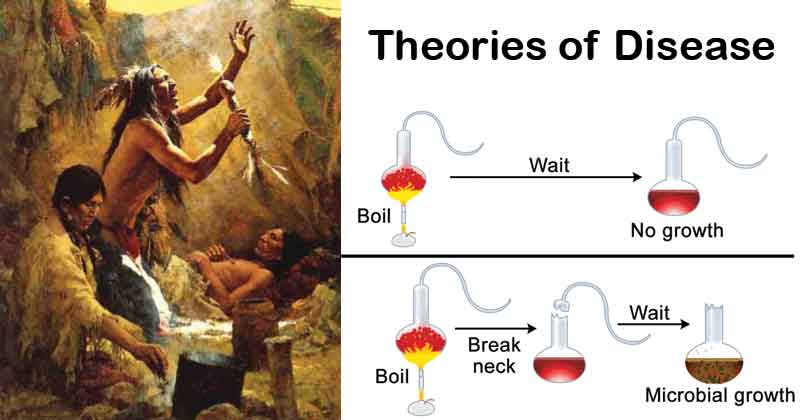- A disorder of structure or function in a human, animal, or plant, especially one that produces specific signs and symptoms or that affects a specific location and is not simply a direct result of physical injury is called a disease.
- It is a particular abnormal, pathological condition that affects part or all of an organism. It is often construed as a medical condition associated with specific symptoms and signs.

Interesting Science Videos
There are four main types of diseases:
- Pathogenic disease
- Deficiency disease
- Hereditary disease
- Physiological disease
In addition to that, diseases may be communicable or non-communicable.
Theories of Disease: Then and Today
- For long, man was groping in darkness about the causation of disease.
- Several theories were advanced from time to time to explain disease causation such as the supernatural theory of disease, the theory of humors by Greeks and Indians, the theory of contagion, the miasmatic theory which attributed disease to noxious air and vapours, the theory of spontaneous generation, etc.
- The breakthrough came in 1860, when the French bacteriologist Louis Pasteur (1822-1895) demonstrated the presence of bacteria in air. He disproved the theory of “spontaneous generation”.
- In 1873, Pasteur advanced the “germ theory of disease”.
- In 1877, Robert Koch (1843-1910) showed that anthrax was caused by a bacteria.
- The discoveries of Pasteur and Koch confirmed the germ theory of disease. It was the golden age of bacteriology.
- Microbe after microbe was discovered in quick succession gonococcus in 1847; typhoid bacillus, pneumococcus in 1880; tubercle bacillus in 1882; cholera vibrio in 1883; diphtheria bacillus in 1884, and so on.
- These discoveries and a host of others at the turn of the century marked a turning point in our aetiological concepts.
- All attention was focused on microbes and their role in disease causation.
- The germ theory of disease came to the forefront, supplanting the earlier theories of disease causation.
- Medicine finally shed the rags of dogma and superstition and put on the robes of scientific knowledge.
1. Supernatural Theory of Disease
- In the early past, the disease was thought mainly due to either the curse of god or due to the evil force of the demons.
- Accordingly, people used to please the gods by prayers and offerings or used to resort to witchcraft to tame the devils.
2. The Theory of Humor
- According to this theory, the human body contains blood, phlegm, yellow bile and black bile. These are the things that make up its constitution and cause its pains and health.
- Health is primarily that state in which these constituent substances are in the correct proportion to each other, both in strength and quantity, and are well mixed.
- Pain occurs when one of the substances presents either a deficiency or an excess, or is separated in the body and not mixed with others.
3. The Theory of Contagion
- Galen had written of the possibility of seeds of disease, a view which suggested a belief in the contagious nature of some diseases.
- Galen’s ‘seeds’ were intended to explain why some people contracted a particular disease while others escaped and he located them within the body.
4. The Miasma Theory
- The miasma theory was the predominant theory of disease transmission before the germ theory took hold towards the end of the 19th century, and it is no longer accepted as a scientific theory of disease.
- It held that diseases such as cholera, chlamydia infection, or the Black Death were caused by a miasma, a noxious form of “bad air” emanating from rotting organic matter.
- Miasma was considered to be a poisonous vapor or mist filled with particles from decomposed matter (miasmata) that was identifiable by its foul smell.
- The theory posited that diseases were the product of environmental factors such as contaminated water, foul air, and poor hygienic conditions.
- Such infections, according to the theory, were not passed between individuals but would affect those within a locale that gave rise to such vapors.
5. Germ Theory of Disease
- The germ theory of disease is the currently accepted scientific theory for many diseases.
- It states that microorganisms known as pathogens or “germs” can lead to disease.
- These small organisms, too small to see without magnification, invade humans, other animals, and other living hosts.
- Their growth and reproduction within their hosts can cause disease.
- Even when a pathogen is the principal cause of a disease, environmental and hereditary factors often influence the severity of the disease, and whether a potential host individual becomes infected when exposed to the pathogen.
References
- http://infectiousdiseases.edwardworthlibrary.ie/theory-of-contagion/
- Feezer L. W. (1921). THEORIES CONCERNING THE CAUSATION OF DISEASE. American journal of public health (New York, N.Y. : 1912), 11(10), 908–912. doi:10.2105/ajph.11.10.908
- Park, K. (n.d.). Park’s textbook of preventive and social medicine.
- Gordis, L. (2014). Epidemiology (Fifth edition.). Philadelphia, PA: Elsevier Saunders.
- https://www.researchgate.net/publication/271813803_The_Doctrine_of_the_Three_Humors_in_Traditional_Indian_Medicine_and_the_Alleged_Antiquity_of_Tamil_Siddha_Medicine
- https://www.nlpworld.co.uk/meta_health/meta-medicine-summary-biological-law/
- https://reviews.history.ac.uk/review/965
- https://www.jstor.org/stable/2862709?seq=1#page_scan_tab_contents
- https://www.slideshare.net/singh_br1762/theories-of-disease-causation

such a great article. thank you so much.
Such a great article. soo glad to read.